Behind the scenes of the classic Frankenstein films
Universal's classic series of horror films are horror films that were made between the 1930s and 1950s and had a significant influence on the development of genre cinema. In 1931, Universal studios released the horror film Dracula. The significant commercial success of this film gave the studio producers confidence that they had found a formula for success and the theme of monsters should be continued.
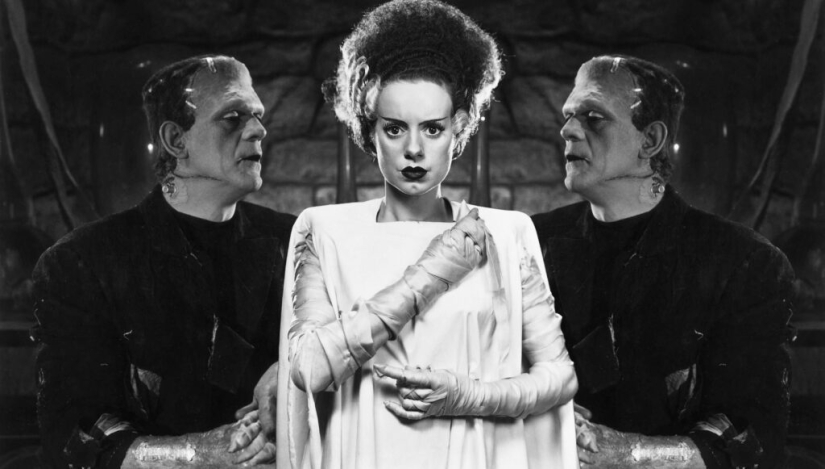
The success of Dracula was cemented by the film Frankenstein, in which the role of the monster was played by Boris Karloff, whose work became a classic and made the actor a new star of horror films. In total, eight films about Frankenstein were made in the designated era. Boris Karloff played in the first three of them. We invite you to look at photos from behind the scenes of these films.
 Frankenstein is a 1931 classic horror film directed by James Whale, an adaptation of Mary Shelley's novel of the same name and Peggy Webling's play based on it. The film became one of the most successful in the “classic series of horror films from Universal Studios.”
Frankenstein is a 1931 classic horror film directed by James Whale, an adaptation of Mary Shelley's novel of the same name and Peggy Webling's play based on it. The film became one of the most successful in the “classic series of horror films from Universal Studios.”
 It was originally planned that the role of the Monster would be played by Bela Lugosi, and the film would be directed by Robert Florey. However, Flory quickly dropped out of the project, and James Whale, who was invited instead, disagreed with Lugosi in their views on the production. After the first auditions, Lugosi refused to participate in the film, saying that he was not interested in a role without words and that he did not want to spend a long time putting on makeup. In the end, Whale found Boris Karloff for the role.
It was originally planned that the role of the Monster would be played by Bela Lugosi, and the film would be directed by Robert Florey. However, Flory quickly dropped out of the project, and James Whale, who was invited instead, disagreed with Lugosi in their views on the production. After the first auditions, Lugosi refused to participate in the film, saying that he was not interested in a role without words and that he did not want to spend a long time putting on makeup. In the end, Whale found Boris Karloff for the role.
 Mary Shelley's novel does not describe the way Frankenstein brings the Monster to life. The scene of revival with the help of electricity, first used in Whale’s film, instantly became a tradition and subsequently all other film adaptations were based on it. The topic of a donor brain is also absent from the novel, but it had a huge influence on the further film development of this plot.
Mary Shelley's novel does not describe the way Frankenstein brings the Monster to life. The scene of revival with the help of electricity, first used in Whale’s film, instantly became a tradition and subsequently all other film adaptations were based on it. The topic of a donor brain is also absent from the novel, but it had a huge influence on the further film development of this plot.
 Every morning, Karloff had to put on makeup for three and a half hours, and it took another hour and a half to remove the makeup after filming.
Every morning, Karloff had to put on makeup for three and a half hours, and it took another hour and a half to remove the makeup after filming.
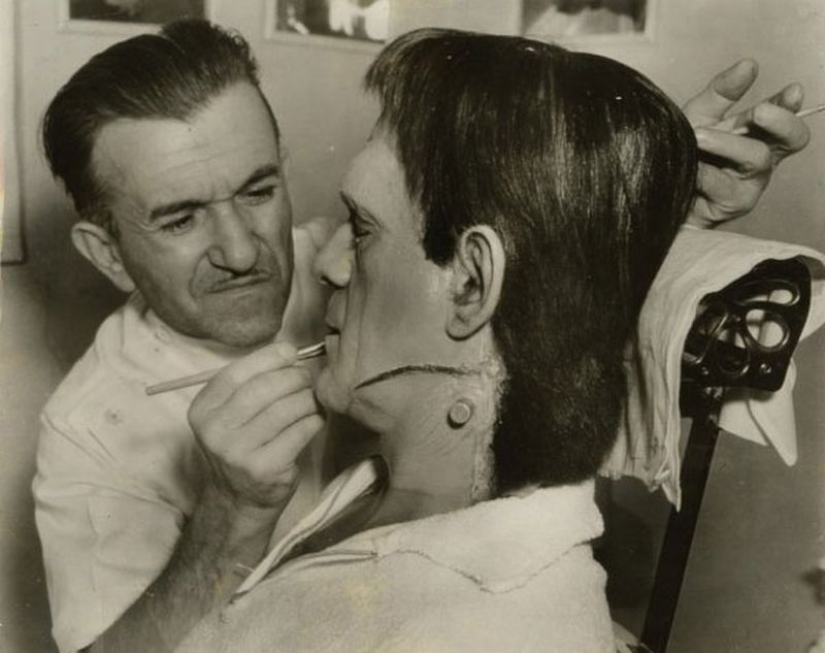 Actor Boris Karloff and legendary makeup artist Jack Pierce.
Actor Boris Karloff and legendary makeup artist Jack Pierce.
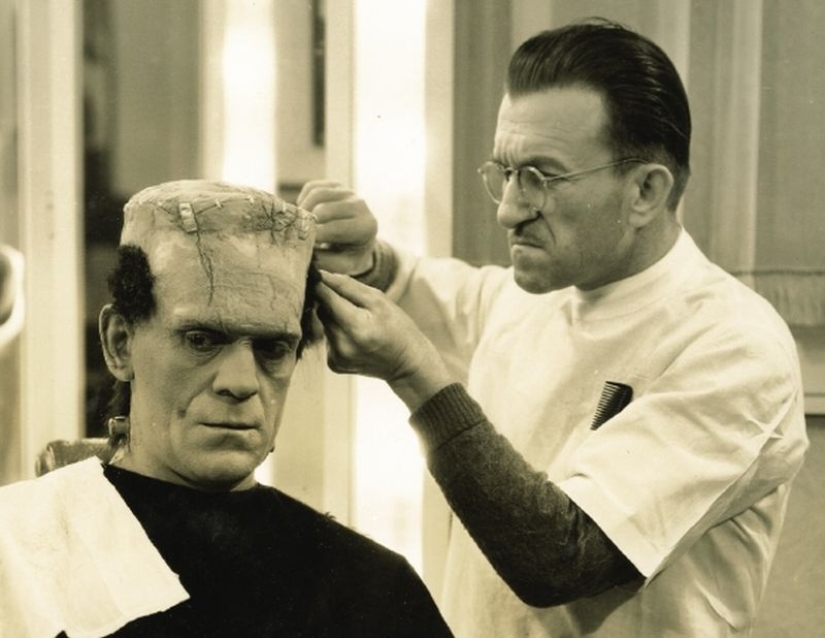 The Beast's makeup and costume weighed about 24 kilograms together.
The Beast's makeup and costume weighed about 24 kilograms together.
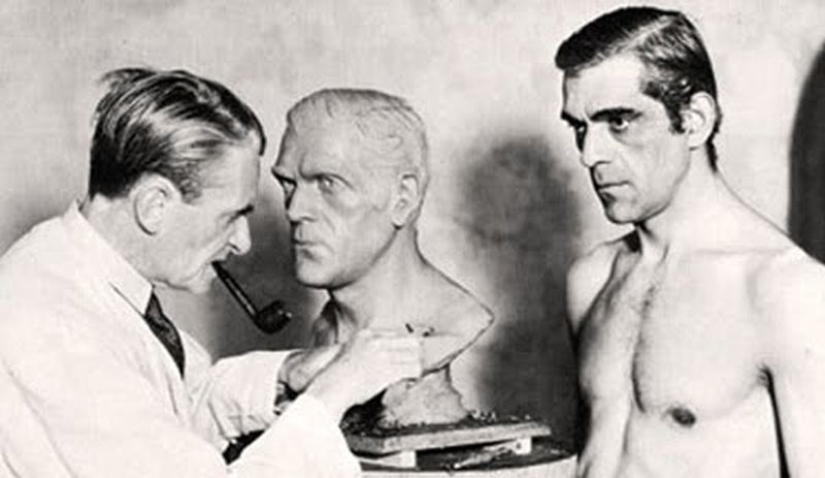 Karloff suggested removing the side dentures from his mouth so that the monster's cheeks would be more sunken.
Karloff suggested removing the side dentures from his mouth so that the monster's cheeks would be more sunken.
 The Monster's appearance was kept a closely guarded secret until the film's premiere. If Karloff had to move around the studio outside the studio in makeup, a pillowcase with holes for the eyes was placed on his head.
The Monster's appearance was kept a closely guarded secret until the film's premiere. If Karloff had to move around the studio outside the studio in makeup, a pillowcase with holes for the eyes was placed on his head.
 The actor's lunches were brought from the dining room directly to the set.
The actor's lunches were brought from the dining room directly to the set.
 Karloff, wearing a bathrobe, takes a break from his heavy suit.
Karloff, wearing a bathrobe, takes a break from his heavy suit.
 Favorite toasts.
Favorite toasts.
 Actor's gatherings.
Actor's gatherings.
 Karloff was wary of filming scenes with electrical discharges flashing above him. In these scenes, he was replaced, covering his face, by the creator of the electrical machinery for the film, Ken Strickfaden.
Karloff was wary of filming scenes with electrical discharges flashing above him. In these scenes, he was replaced, covering his face, by the creator of the electrical machinery for the film, Ken Strickfaden.
 To create the image of the Monster, Jack Pierce specially studied ancient burial techniques and anatomy.
To create the image of the Monster, Jack Pierce specially studied ancient burial techniques and anatomy.
 The top of the head was cut off because Pierce believed it would be easier for Frankenstein to directly transplant the brain into his monster.
The top of the head was cut off because Pierce believed it would be easier for Frankenstein to directly transplant the brain into his monster.
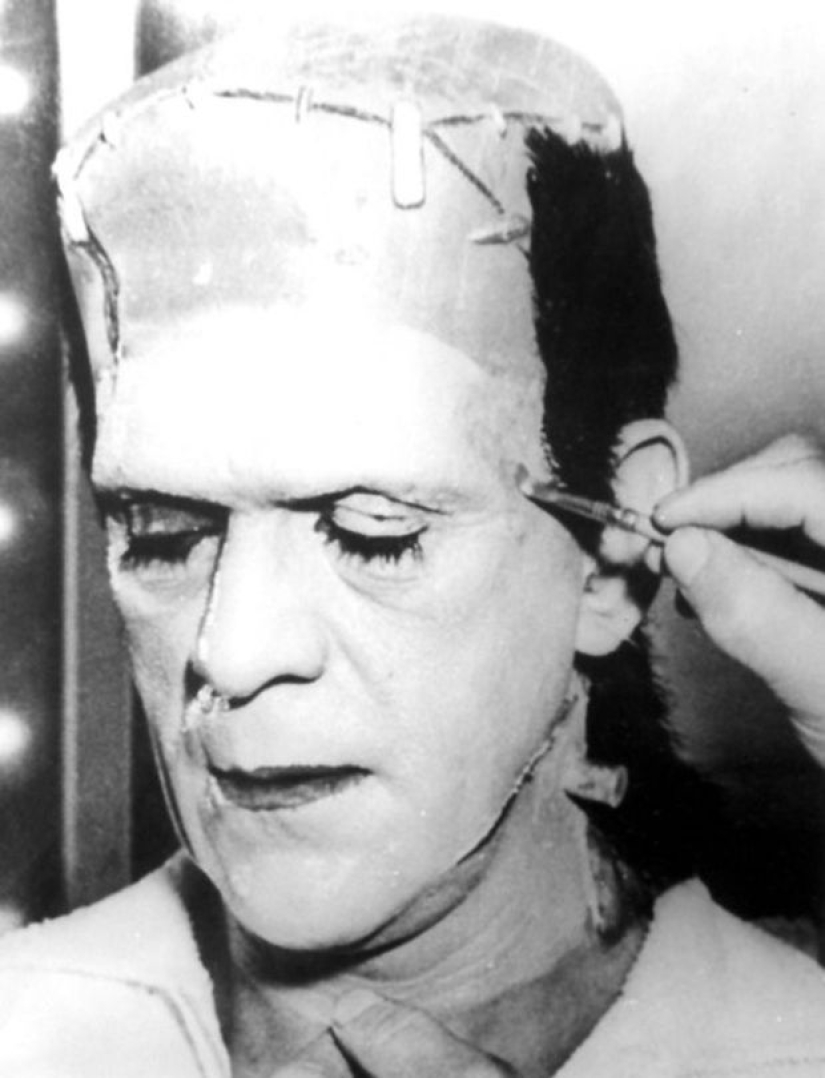 The film, according to the producers, turned out to be so scary that they insisted on adding an introductory episode in which Edward van Sloan warned viewers that it was better for the faint of heart to leave the theater.
The film, according to the producers, turned out to be so scary that they insisted on adding an introductory episode in which Edward van Sloan warned viewers that it was better for the faint of heart to leave the theater.
 The scene in which the Monster throws the girl into the water was cut from the theatrical release of the film due to censorship requirements as being too violent. Subsequently, the film also underwent a number of cuts. However, the deleted materials have been preserved and the version that is currently being published on video media is almost entirely consistent with the original editing.
The scene in which the Monster throws the girl into the water was cut from the theatrical release of the film due to censorship requirements as being too violent. Subsequently, the film also underwent a number of cuts. However, the deleted materials have been preserved and the version that is currently being published on video media is almost entirely consistent with the original editing.
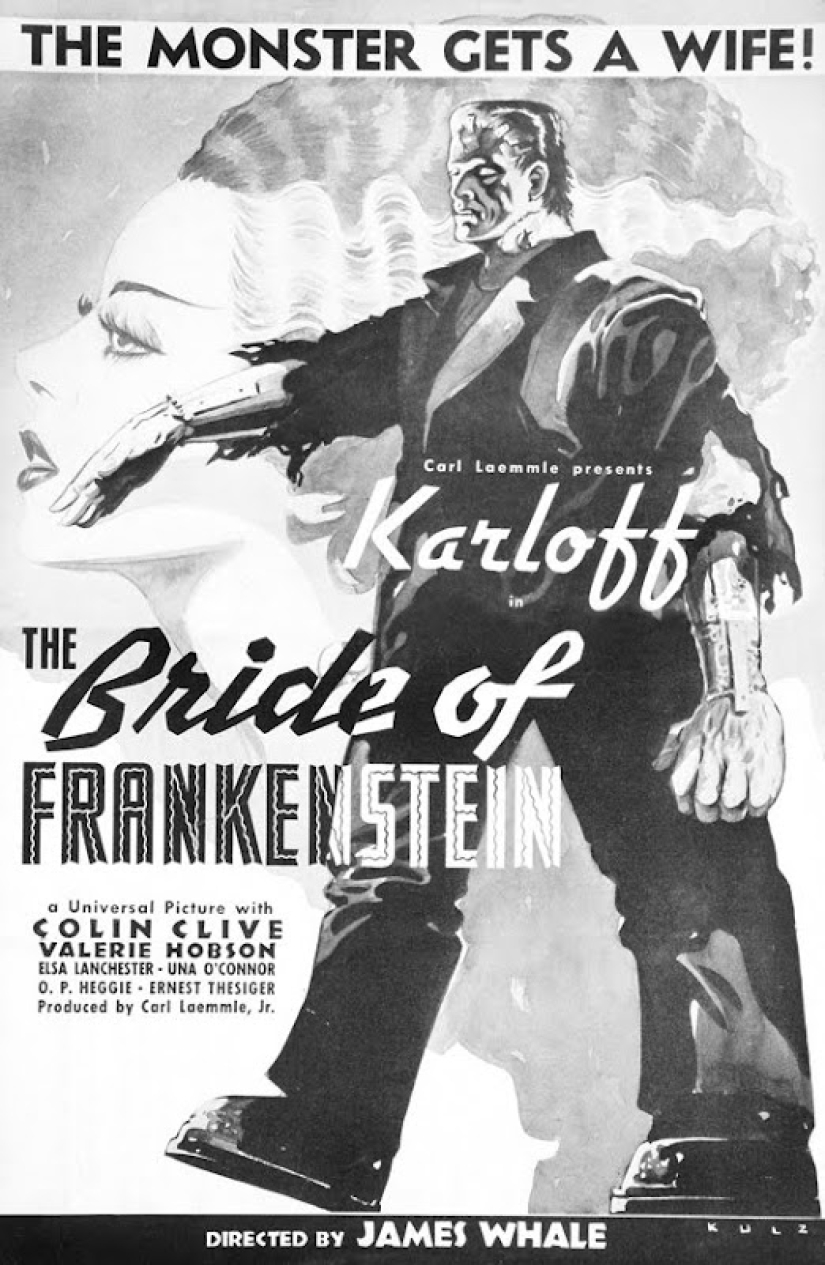 "Bride of Frankenstein" is a feature film by James Whale, a classic horror film with comedy elements, a direct continuation of the film "Frankenstein". The film premiered in the United States on April 22, 1935.
"Bride of Frankenstein" is a feature film by James Whale, a classic horror film with comedy elements, a direct continuation of the film "Frankenstein". The film premiered in the United States on April 22, 1935.
 In the novel, Frankenstein refuses his promise to the monster to create a girlfriend for him, for which the Monster takes terribly revenge on him. The movie monster was luckier.
In the novel, Frankenstein refuses his promise to the monster to create a girlfriend for him, for which the Monster takes terribly revenge on him. The movie monster was luckier.
 The role of the bride was played by the magnificent Elsa Lanchester.
The role of the bride was played by the magnificent Elsa Lanchester.
 The bride is resting.
The bride is resting.
 Henry Frankenstein (Colin Clive) gives his creation a light.
Henry Frankenstein (Colin Clive) gives his creation a light.
 Karloff broke his leg while filming. During further filming, a metal pin on his shin, which was supposed to make his gait heavier, was taped to his broken leg as a splint to fix the cracked bone.
Karloff broke his leg while filming. During further filming, a metal pin on his shin, which was supposed to make his gait heavier, was taped to his broken leg as a splint to fix the cracked bone.
 The sound for the film was recorded by a live orchestra.
The sound for the film was recorded by a live orchestra.
 The enormous success of Bride of Frankenstein led to several more sequels. On January 13, 1939, Son of Frankenstein was released.
The enormous success of Bride of Frankenstein led to several more sequels. On January 13, 1939, Son of Frankenstein was released.
 Son of Frankenstein director Rowland W. Lee (right) and the film's main characters: Igor (Bela Lugosi), the Monster (Boris Karloff) and Baron Wolf von Frankenstein (Basil Rathbone).
Son of Frankenstein director Rowland W. Lee (right) and the film's main characters: Igor (Bela Lugosi), the Monster (Boris Karloff) and Baron Wolf von Frankenstein (Basil Rathbone).
 They're having tea.
They're having tea.
 The monster cuts the birthday cake.
The monster cuts the birthday cake.
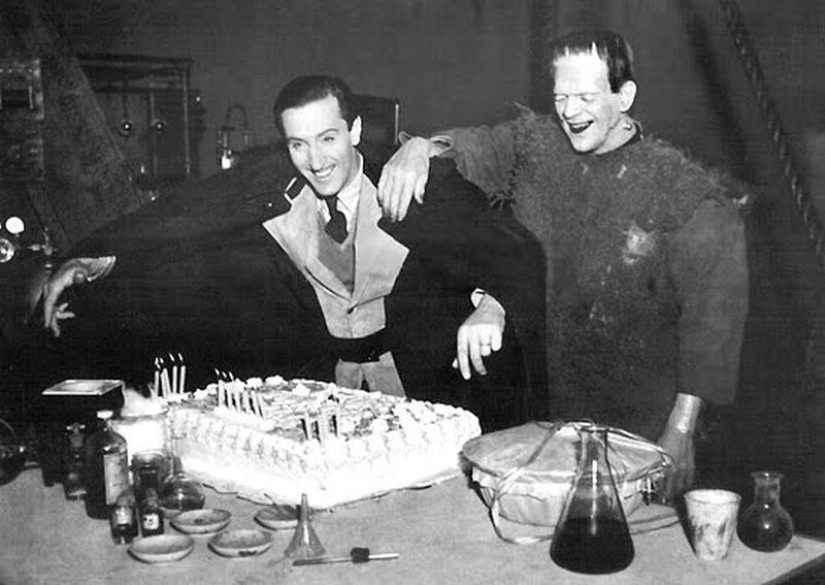 Basil Rathbone and Boris Karloff.
Basil Rathbone and Boris Karloff.
 Frankenstein, the Monster and Igor.
Frankenstein, the Monster and Igor.
 In this film, the character of the monster has changed. Unlike The Bride of Frankenstein, he didn't speak anymore and was very sullen.
In this film, the character of the monster has changed. Unlike The Bride of Frankenstein, he didn't speak anymore and was very sullen.
 Rathbone and Karloff with 4-year-old Donnie Dunagan, who played the role of Peter von Frankenstein.
Rathbone and Karloff with 4-year-old Donnie Dunagan, who played the role of Peter von Frankenstein.
 Boris Karloff with his friends - the Brown family. After this film, Karloff did not play the Monster in any other Frankenstein films.
Boris Karloff with his friends - the Brown family. After this film, Karloff did not play the Monster in any other Frankenstein films.
Recent articles

The animal kingdom can be cruel and dangerous. So what should small and non-fanged animals do to protect themselves, or the same ...

Immunity to poisons at all times been the dream of all authority. List of popes, kings and emperors, gave his soul to God through ...

The primary mission of any doctor is to save lives and help those afflicted by illness. Unfortunately, history is replete with ...